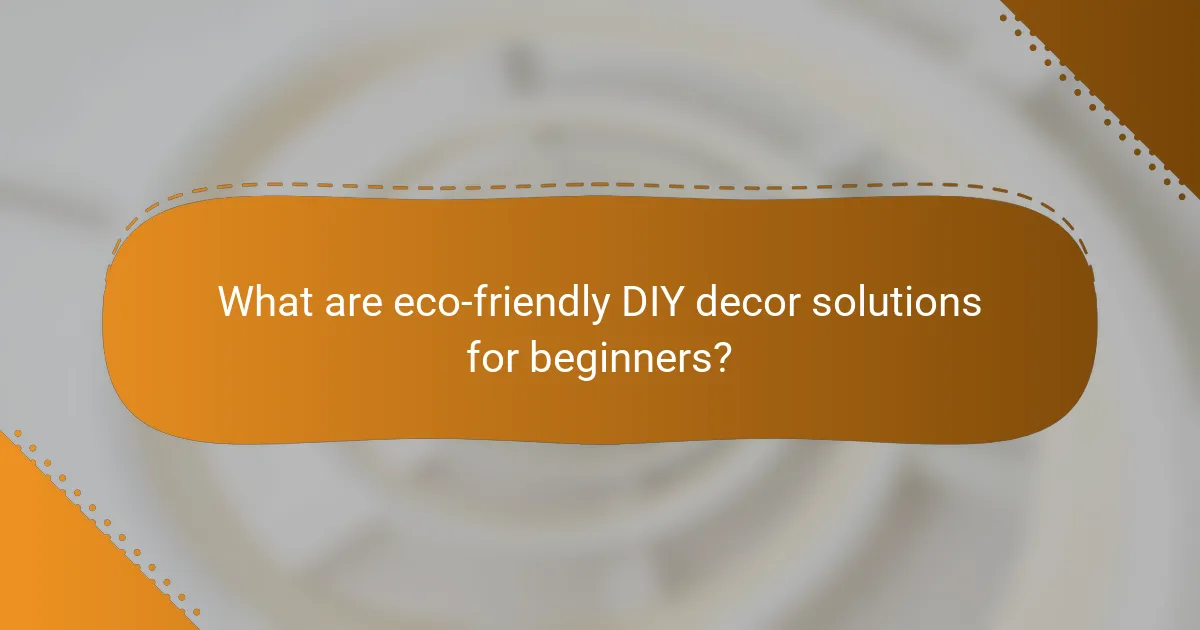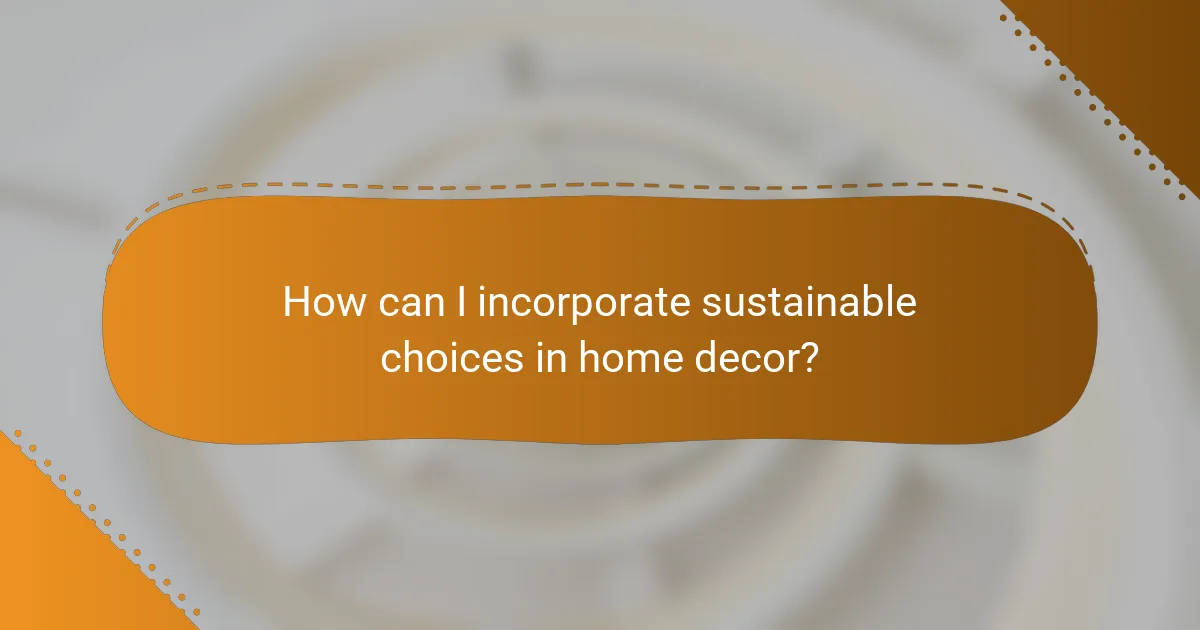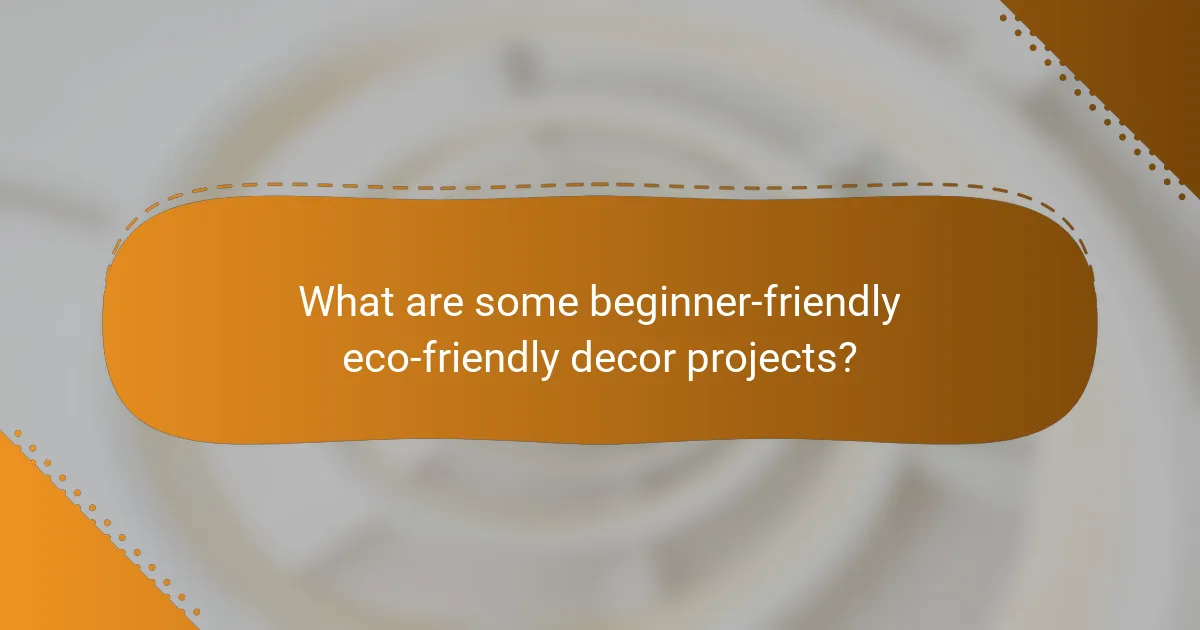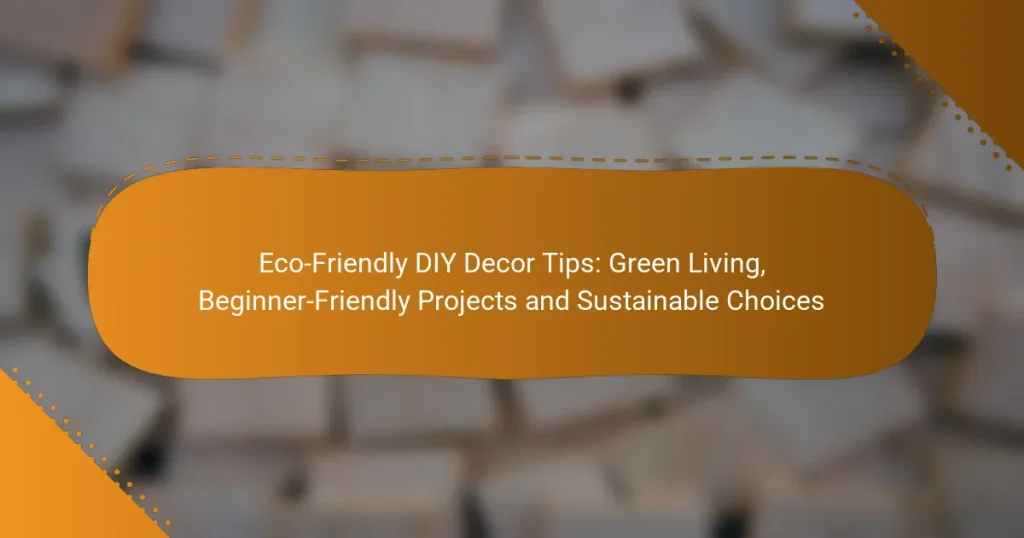Transform your living space with eco-friendly DIY decor projects that are perfect for beginners. By using sustainable materials and methods, you can create beautiful home accents that reduce waste and promote green living. These accessible projects not only enhance your environment but also encourage creativity while making a positive impact on the planet.

What are eco-friendly DIY decor solutions for beginners?
Eco-friendly DIY decor solutions for beginners involve using sustainable materials and methods to create attractive home accents. These projects are accessible, often require minimal investment, and help reduce waste while enhancing your living space.
Upcycled furniture projects
Upcycling furniture involves transforming old or discarded pieces into functional and stylish items. For instance, you can repaint a wooden chair or turn an old dresser into a chic TV stand. Look for sturdy items that just need a little creativity to shine again.
Consider using non-toxic finishes and paints to maintain the eco-friendly aspect of your project. Check local thrift stores or online marketplaces for affordable options to start your upcycling journey.
Natural material wall art
Creating wall art from natural materials is a simple way to add a rustic touch to your decor. You can use branches, leaves, or stones to craft unique pieces. For example, arrange dried flowers in a frame or create a collage with pressed leaves.
Ensure that any materials you collect are sourced sustainably, avoiding protected areas or endangered species. This approach not only beautifies your space but also connects you with nature.
Repurposed glass jar planters
Repurposing glass jars as planters is an easy and effective DIY project. You can use jars of various sizes to grow herbs, succulents, or small flowers. Simply add soil and seeds or seedlings, and place them in a sunny spot.
To enhance drainage, consider adding small stones at the bottom of the jar. This method not only reduces waste but also adds a charming touch to your home or garden.
Eco-friendly paint options
When selecting paint for your DIY projects, opt for eco-friendly options that are low in volatile organic compounds (VOCs). Brands that offer natural or organic paints are widely available and provide a safer alternative for indoor air quality.
Look for certifications like Green Seal or the EPA’s Safer Choice label to ensure the paint meets environmental standards. These paints often come in a variety of colors and finishes, allowing you to achieve your desired look while being mindful of the environment.
Biodegradable craft supplies
Using biodegradable craft supplies is a great way to minimize your environmental impact while engaging in DIY projects. Materials such as paper, cotton, and natural adhesives break down more easily than synthetic options.
When shopping for supplies, check labels for biodegradable claims and consider purchasing from local artisans or eco-conscious brands. This not only supports sustainable practices but also often results in higher-quality materials for your projects.

How can I incorporate sustainable choices in home decor?
Incorporating sustainable choices in home decor involves selecting materials and products that are environmentally friendly, ethically sourced, and energy-efficient. This approach not only reduces your carbon footprint but also promotes a healthier living space.
Using reclaimed wood
Reclaimed wood is a sustainable choice that repurposes old timber from buildings, furniture, or pallets, reducing the need for new lumber. This material often has unique character and history, adding charm to your decor.
When using reclaimed wood, ensure it is properly treated to eliminate pests and contaminants. Look for local suppliers or salvage yards to find quality pieces that fit your aesthetic while supporting local businesses.
Choosing organic fabrics
Organic fabrics are made from materials grown without synthetic pesticides or fertilizers, making them a healthier choice for your home. Common options include organic cotton, linen, and hemp, which are not only eco-friendly but also durable.
When selecting organic fabrics, check for certifications such as GOTS (Global Organic Textile Standard) to ensure authenticity. Incorporating these materials in upholstery, curtains, or bedding can significantly reduce exposure to harmful chemicals.
Investing in energy-efficient lighting
Energy-efficient lighting, such as LED bulbs, consumes less electricity and lasts significantly longer than traditional incandescent bulbs. This choice not only lowers your energy bills but also reduces greenhouse gas emissions.
Consider replacing your home’s lighting with LED options, which can use up to 80% less energy. Look for products with the ENERGY STAR label to ensure high efficiency and quality. Additionally, using dimmers and smart lighting systems can further enhance energy savings while providing flexibility in ambiance.

What are some beginner-friendly eco-friendly decor projects?
Beginner-friendly eco-friendly decor projects are simple, sustainable crafts that utilize recycled materials or natural resources. These projects not only enhance your living space but also promote green living by reducing waste and encouraging creativity.
DIY herb garden from recycled containers
Creating a DIY herb garden using recycled containers is an excellent way to grow fresh herbs while minimizing waste. You can use old jars, tin cans, or plastic bottles, ensuring they are clean and have drainage holes at the bottom.
Fill the containers with potting soil and plant your favorite herbs, such as basil, mint, or parsley. Position them in a sunny spot, and remember to water them regularly. This project not only beautifies your space but also provides fresh ingredients for your meals.
Creating a macrame plant hanger
A macrame plant hanger is a stylish way to display your plants while adding a touch of bohemian flair to your decor. To start, gather some cotton or jute rope, scissors, and a pot for your plant.
Cut the rope into equal lengths, then tie knots to create a secure holder for your pot. Hang it from a ceiling hook or wall bracket. This project is not only fun but also allows you to repurpose materials you may already have at home.
Making natural dye for fabrics
Making natural dye for fabrics is a creative and eco-friendly way to add color to your textiles. You can use items like onion skins, beetroot, or avocado pits to create vibrant dyes.
Simply boil the dye materials in water, strain the liquid, and soak your fabric in the dye bath for a few hours. Rinse and dry the fabric to reveal beautiful, earthy tones. This method is safe and non-toxic, making it perfect for beginners interested in sustainable crafting.

What criteria should I consider for sustainable decor?
When selecting sustainable decor, consider the materials used, the product lifecycle, and whether items are locally sourced or imported. These factors significantly impact environmental footprints and support eco-friendly practices.
Material sourcing
Material sourcing is crucial for sustainable decor. Opt for natural, renewable resources like bamboo, reclaimed wood, or recycled materials. Avoid products made from harmful chemicals or non-biodegradable substances, as these contribute to pollution and waste.
Look for certifications such as FSC (Forest Stewardship Council) for wood products or GOTS (Global Organic Textile Standard) for textiles. These labels indicate responsible sourcing and production practices.
Product lifecycle
Understanding a product’s lifecycle helps assess its sustainability. Consider how long the item will last, how it was made, and what happens at the end of its life. Durable products that can be repaired or recycled are preferable.
Evaluate the energy and resources consumed during production and transportation. Aim for items designed for longevity and minimal environmental impact, reducing waste over time.
Local vs. imported goods
Choosing local goods often reduces carbon footprints associated with transportation. Local artisans may use sustainable practices and materials, supporting the community while minimizing environmental impact.
Imported goods can sometimes offer unique styles but may involve higher emissions due to shipping. Weigh the benefits of unique designs against the ecological costs, and consider supporting local businesses whenever possible.

What are the costs associated with eco-friendly decor?
The costs of eco-friendly decor can vary widely based on materials, project complexity, and sourcing. Generally, DIY projects can be more budget-friendly, while investing in sustainable brands may require a higher upfront cost but can lead to long-term savings and environmental benefits.
Budget-friendly DIY options
Creating eco-friendly decor on a budget is achievable through simple DIY projects. Upcycling old furniture, using reclaimed wood, or crafting decorations from natural materials can significantly reduce costs. For example, turning glass jars into candle holders or using fabric scraps for wall art can be both economical and stylish.
Consider sourcing materials from local thrift stores, garage sales, or even your own home. This not only saves money but also minimizes waste. A budget of around $50 to $100 can cover several small projects, depending on the materials you choose.
Investment in sustainable brands
Investing in sustainable decor brands often involves higher initial costs due to ethical sourcing and environmentally friendly practices. However, these products are typically made to last longer, reducing the need for replacements and ultimately saving money over time. Brands that prioritize sustainability may offer items ranging from organic textiles to furniture made from recycled materials.
When considering sustainable brands, look for certifications like Fair Trade or products made from renewable resources. While prices can vary, expect to pay a premium of 20% to 50% more than conventional options. This investment supports eco-friendly practices and contributes to a healthier planet.


